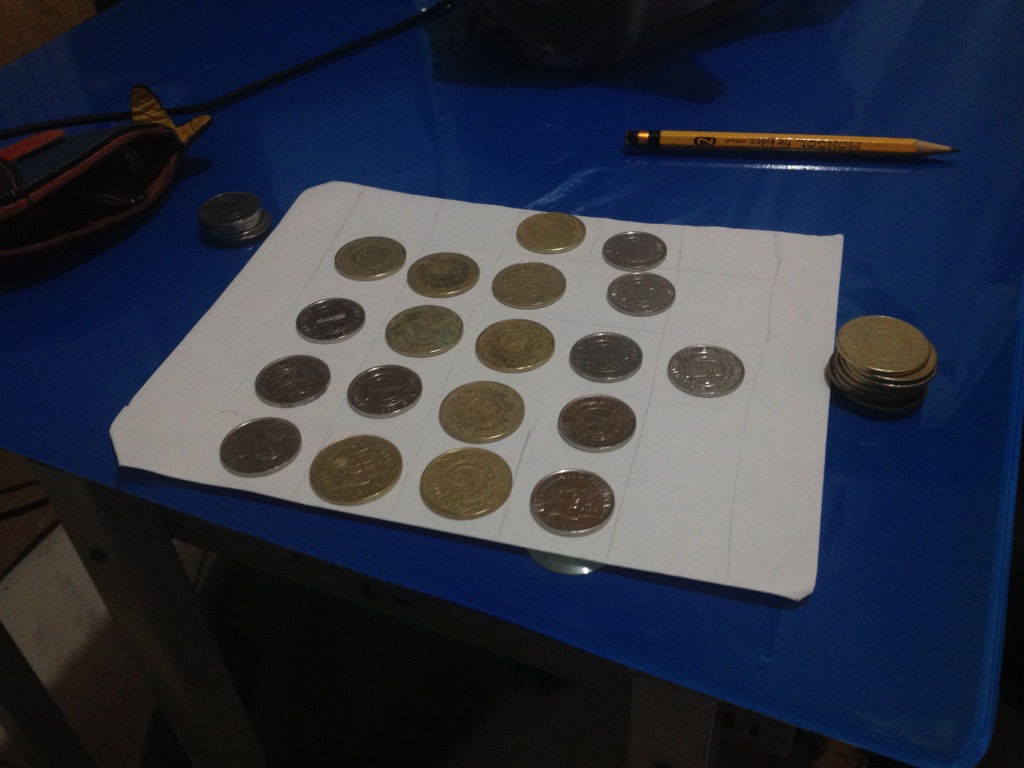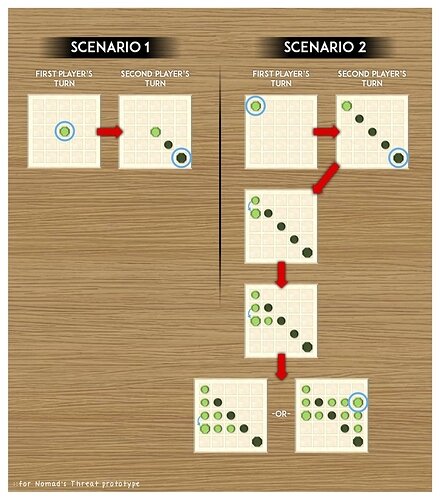Good day! 
Sharing my work for the Grid Game session. This was built upon Majority Win Condition and the idea of trying to run away from the opponent instead of capturing it, plus a strategic player-turn change. Looking for feedback. The game can be played with two sets of coins and a pencil-drawn grid.
TITLE and OVERVIEW
Nomads’ Threat
A two-player turn-based strategic board game
VICTORY CONDITIONS
(Majority Win Condition) Immediately after all tiles have been occupied, the player with the most number of tent pieces on the board wins.
THEME CONCEPT
The nomads have always been peaceful and have lived straying away from conflicts. But the appearance of another tribe brings uncertainty in the scarce resources of the land and threatens their security. So in response, the chief decides the tribe to move farther out and set camps as passive intimidation to the foreseen enemy.
INTENDED PLAYER EXPERIENCE
A sense of achievement from “running away” or keeping distance from the enemy.
A gameplay experience that has the appeal similar to a classic or ancient board game such as Chinese checkers or backgammon.
MECHANICS and RULES
-
The game is played by placing tent pieces on a 5x5 grid.
- The board starts empty.
- Each tile can only be occupied by one piece.
-
A player may increase his number of tent pieces by wandering.
- Moving a piece increases the number of pieces.
- Any tent piece on the board belonging to the player may be moved to an adjacent empty tile vertically, horizontally, or diagonally during the player’s turn. This is called wandering.
- Whenever a tent piece wanders, the tent transfers on the empty tile and a new tent piece is placed/created on the tile it came from (increasing the player’s number of tents).
- Whenever the player’s tent piece wanders to a tile on the same row, column, or diagonal as an opponent’s piece and only empty tiles are between them, then that player places/creates a tent piece on every empty tile between his wandering piece and the opponent’s tent. (i.e.: The farther the player’s wandering piece is to the opponent’s piece, the more tents are created for the player.) This is called camping.
- Camping may happen on more than one row, column, or diagonal at the same time.
-
Chief Tents are special tent pieces.
- Each player has two Chief Tents aside from the regular tent pieces. The Chief Tents look different and a little larger than regular tents.
- A Chief Tent is placed by the player and enters the board on any empty tile but wanders similar to regular tent pieces.
- Because regular tent pieces only enter the board from wandering or camping, each player starts their first turn by placing a Chief Tent.
- Whenever a Chief Tent enters the board, camping must happen if applicable. (i.e.: If the player’s Chief Tent is placed on an empty tile with an opponent’s piece on the same row, column, or diagonal and only empty tiles are between them, camping occurs for the player.)
-
A player’s turn is decided by the number of tents.
- Initially, the players decide or agree who starts first.
- During the game, a player may keep wandering during his turn as long as his number of tents on the board is less than or equal to his opponent’s. When his pieces exceed the opponent’s number of pieces, the player ends his turn and the opponent’s turn begins.
-
The game ends when all tiles are occupied, or when the player (the one taking his turn) runs out of available moves. After this, the player with the most number of tent pieces on the board wins. (A draw game is possible if the game ends without all tiles being occupied.)
I suggest trying to play with the above rules first before trying the additional mechanism below.
- A player may decrease his opponent’s number of tent pieces by invading.
- Invading is like attacking or capturing opponent’s pieces.
- A player may only invade by moving his Chief Tent to an adjacent opponent’s regular tent piece (horizontally, vertically, or diagonally).
- A Chief Tent may only invade if the tent to be invaded is NOT adjacent to an opponent’s Chief Tent (or in terms of game theme, regular tent pieces are protected by the adjacent Chief Tent).
- By invading, the player moves his Chief Tent to the tile occupied by the opponent’s regular tent. In doing so, the opponent’s tent piece is removed from the board and the player occupies the invaded tile with his Chief Tent.
- Unlike wandering, no tent is created on the tile the Chief Tent piece came from.
- The player ends his turn immediately after invading (i.e. even if the invading player has fewer pieces on the board).
SUMMARY OF PLAYER CHOICE (Chunked)
- Place Chief Tent on the board.
- Move one tent piece to wander.
- Invade an opponent’s tent.
OBSERVATION and OTHER NOTES
- The strategy appears to build up nicely from early to mid-game, with early game more focused on increasing tents, while mid-game on proper tent positioning.
- Strategic positioning of tents become more crucial later in the game.
- The swarming mechanism adds a calculated decision to player experience (whether to run away from or chase the opponent piece), but at the same time still promotes running away over chasing opponent due to the disadvantage of losing a swarming tent.
- Due to losing own piece, swarming appears to be effective solely for positioning purposes.
- Originally intended to be a fast game, the playing time significantly increases with the swarming mechanism. It may be hard for new or familiar players to end the game due to swarming preventing all 25 tiles of the board from being filled. More experienced player, however, may finish the game faster.
- Playing time may be reduced by adding one more Chief Tent or with the use of sand timer, wherein the sand timer is activated once all Chief Tents have been placed.
- Because the grid is only 5x5, a sure-win strategy may possibly exist.
As of February 2018…
- Swarming has been removed as it makes the game duration long and dragging, which is not the intended player experience for the game. Some mechanism of it may return when observed necessary after more playtests. For archiving purposes, the rules in swarming are listed below:
A player may decrease his opponent’s number of tent pieces by swarming.- Swarming is like attacking or capturing opponent’s pieces.
- A player may use his tent piece/s to swarm an opponent’s adjacent tent piece (horizontally, vertically, or diagonally).
- Generally, more than one tent piece is required to swarm.
- By swarming, the player moves his tent pieces to the tile occupied by the opponent’s tent. In doing so, the opponent’s tent piece is removed from the board and the player occupies the swarmed tile with one of his swarming tents. (Generally, the swarming player also loses a tent or two.)
- Unlike wandering, no tent is created on the tile the swarming piece came from.
- Swarming can only happen when the player overpowers his opponent’s tent piece. Listed below are the required number of player’s tent pieces to swarm an opponent’s piece (while also specifying how many swarming tents are lost).
- Two regular tents can swarm one regular tent. (Lose one.)
- Three regular tents can swarm one Chief Tent. (Lose two.)
- One Chief Tent can swarm one regular tent. (Lose none. Chief Tent remains.)
- One Chief Tent with one other tent, whether regular or Chief, can swarm one Chief Tent. (Lose the other tent. One Chief Tent remains.)
- Only one swarming piece remains (the other swarming pieces are removed from the board).
- Chief Tents cannot be played again during the game once removed from the board.
- The player ends his turn immediately after swarming (i.e. even if the player has fewer pieces on the board).
Image of Nomad’s Threat prototype:
(coins with heads up are Chief Tents)
EDIT 1: minor edit
EDIT 2: added Theme Concept part
EDIT 3: improved some wordings EDIT 4: swarming is removed and replaced with invading



 Thanks for the feedback, sir.
Thanks for the feedback, sir.